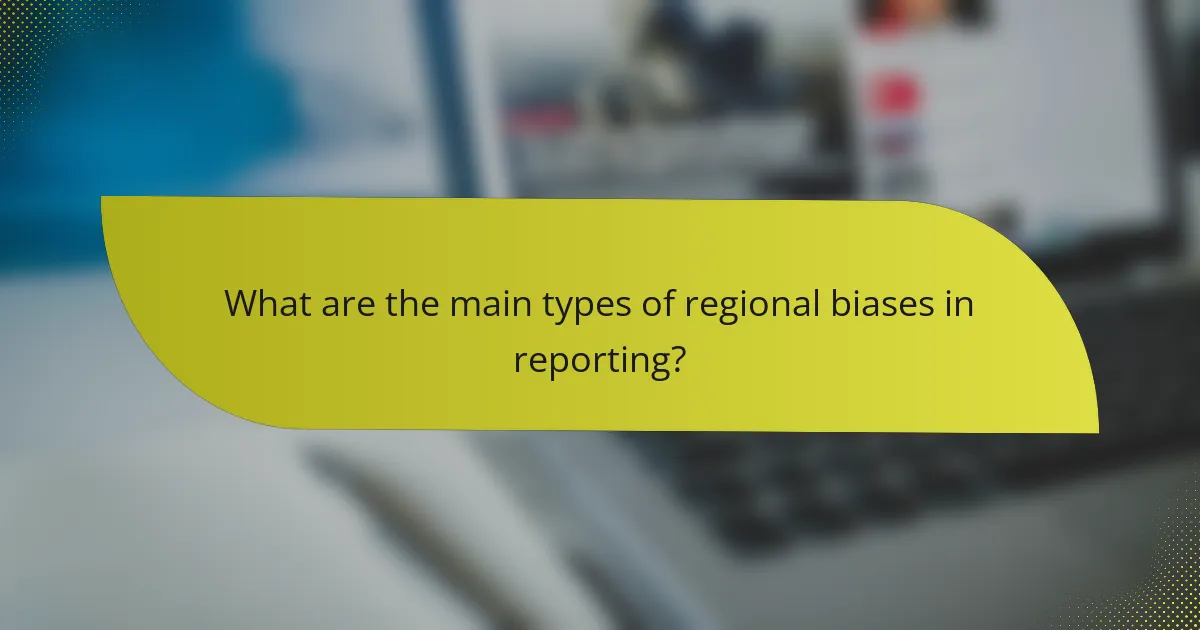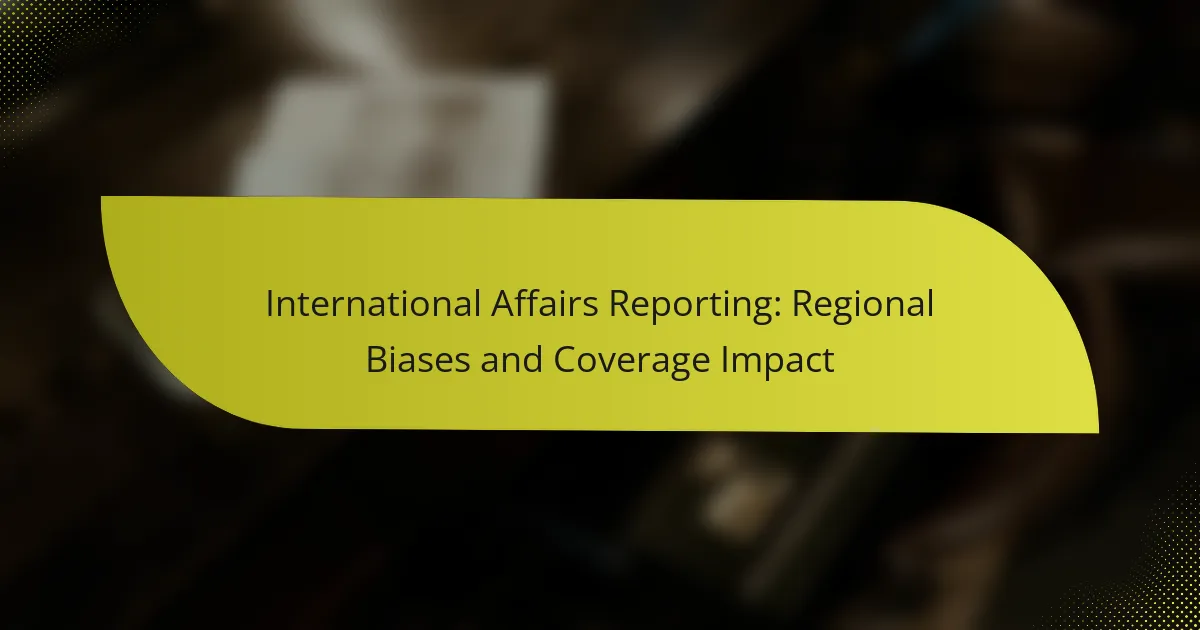Regional biases play a crucial role in shaping international affairs reporting, affecting the portrayal of events and the prioritization of stories. These biases can create skewed narratives that influence public perception and understanding of global issues, highlighting the need for more balanced coverage. By employing diverse sourcing and enhancing cultural sensitivity, journalists can work towards mitigating these biases and fostering a more accurate representation of international perspectives.

How do regional biases affect international affairs reporting?
Regional biases significantly shape international affairs reporting by influencing how events are portrayed and which stories are prioritized. These biases can lead to skewed narratives that favor certain perspectives, impacting public understanding and engagement with global issues.
Impact on narrative framing
Narrative framing refers to the way stories are constructed and presented, which can be heavily influenced by regional biases. For instance, a conflict in a politically aligned region may be framed as a struggle for democracy, while similar events in less favored areas might be depicted as mere violence or chaos. This selective framing can create a distorted view of international events.
Reporters and editors often unconsciously reflect their own cultural backgrounds and regional affiliations in their storytelling. This can lead to a lack of nuance and depth in coverage, as certain voices and perspectives are amplified while others are marginalized.
Influence on audience perception
Audience perception is shaped by the narratives presented in the media, which can be skewed by regional biases. When news outlets focus on specific angles or omit critical context, audiences may develop a limited understanding of global issues. This can foster stereotypes and reinforce existing prejudices about certain regions or countries.
Moreover, audiences tend to trust sources that align with their own regional perspectives, which can create echo chambers. This reinforces biased narratives and diminishes the likelihood of exposure to diverse viewpoints, further entrenching misconceptions about international affairs.
Examples from major news outlets
Major news outlets often exhibit regional biases in their coverage of international affairs. For example, U.S. media may emphasize stories that highlight American interests or perspectives, while underreporting events in regions deemed less relevant to their audience. This can lead to a disproportionate focus on Western viewpoints.
Similarly, European news organizations might prioritize coverage of issues affecting the EU or neighboring countries, potentially neglecting significant developments in other parts of the world. Such selective reporting can create an imbalanced global narrative that affects public discourse and policy decisions.

What are the main types of regional biases in reporting?
Regional biases in reporting can significantly shape public perception and understanding of international affairs. The main types include geopolitical, cultural, and economic biases, each influencing how events are covered and interpreted across different regions.
Geopolitical biases
Geopolitical biases arise when news coverage favors certain nations or regions based on political alliances or conflicts. For instance, Western media may prioritize stories that align with U.S. interests while downplaying issues in countries that are not aligned with these interests.
This bias can manifest in the selection of topics, framing of narratives, and even the tone used in reporting. Understanding these biases is crucial for consumers of news to critically evaluate the information presented.
Cultural biases
Cultural biases in reporting reflect the values, beliefs, and norms of the media’s home country, which can lead to misrepresentation of other cultures. For example, media outlets may portray non-Western societies through a lens that emphasizes stereotypes or exoticism, rather than presenting a nuanced view.
These biases can affect audience perceptions and foster misunderstandings between cultures. It is important for journalists to strive for cultural sensitivity and accuracy in their reporting to bridge these gaps.
Economic biases
Economic biases occur when media coverage is influenced by the economic interests of the reporting organization or its stakeholders. This can lead to selective reporting on issues that impact advertisers or sponsors, potentially skewing public understanding of important economic events.
For example, a news outlet funded by a corporation may underreport negative news about that corporation’s practices. Consumers should be aware of the financial influences behind news coverage to better assess the reliability of the information presented.

How can journalists mitigate regional biases?
Journalists can mitigate regional biases by employing diverse sourcing, enhancing cultural sensitivity training, and collaborating with fact-checking organizations. These strategies help ensure balanced reporting and a more accurate representation of global perspectives.
Implementing diverse sourcing
Diverse sourcing involves gathering information from a wide range of voices, particularly those from underrepresented regions or communities. This practice can help counteract the tendency to rely on familiar narratives and sources, which may skew coverage.
Journalists should actively seek out local experts, grassroots organizations, and community leaders when reporting on specific regions. For example, instead of only quoting government officials, including perspectives from NGOs or local activists can enrich the narrative.
Training on cultural sensitivity
Cultural sensitivity training equips journalists with the skills to understand and respect the cultural contexts of the communities they report on. This training can help reporters avoid stereotypes and misrepresentations that stem from a lack of cultural awareness.
Workshops and seminars can provide practical insights into local customs, languages, and social dynamics. Journalists should be encouraged to engage with cultural consultants when covering sensitive topics to ensure accuracy and respect.
Utilizing fact-checking organizations
Collaborating with fact-checking organizations can enhance the credibility of journalistic work by verifying claims and providing accurate information. These organizations can help identify biases in reporting and ensure that facts are presented fairly.
Journalists should consider establishing partnerships with reputable fact-checkers, especially when covering contentious issues. This collaboration can help maintain journalistic integrity and build trust with audiences by ensuring that reported information is reliable and well-sourced.

What role do media organizations play in shaping coverage?
Media organizations significantly influence how international affairs are reported, affecting public perception and understanding. Their editorial choices, ownership structures, and specific case studies reveal the underlying biases that can shape coverage of global events.
Editorial policies and guidelines
Editorial policies and guidelines dictate how news is selected, reported, and presented. These policies often reflect the values and priorities of the organization, which can lead to biased coverage based on what stories are deemed newsworthy. For instance, a media outlet may prioritize stories that align with its political stance or audience preferences, potentially omitting critical viewpoints.
To assess the impact of these policies, consider how different organizations report on the same event. Variations in tone, focus, and detail can reveal underlying biases, influencing audience interpretation and understanding of international issues.
Ownership influences
The ownership of media organizations plays a crucial role in shaping coverage, as owners may have specific interests that affect editorial decisions. For example, a media company owned by a conglomerate with business ties in a particular country may present that nation in a more favorable light. This can skew public perception and limit critical discourse on important international matters.
Understanding the ownership structure of a media outlet can provide insights into potential biases. Investigating who owns the media and their interests can help audiences critically evaluate the information presented.
Case studies of specific media organizations
Examining specific media organizations can illustrate how biases manifest in international reporting. For instance, a study of a prominent U.S. news network may reveal a tendency to emphasize Western perspectives while underreporting voices from developing countries. This can lead to a skewed understanding of global issues.
Another example is a European media outlet that may focus heavily on EU-related news, potentially neglecting significant events in non-European regions. Analyzing these case studies helps highlight the diverse approaches to international affairs reporting and the implications of regional biases.

What are the consequences of biased reporting on global issues?
Biased reporting on global issues can lead to significant misunderstandings and misinterpretations among the public. This distortion of information affects perceptions, opinions, and ultimately, decision-making processes across various sectors.
Public misinformation
Public misinformation arises when biased reporting presents skewed facts or narratives, leading audiences to form incorrect beliefs about global events. For instance, selective coverage of conflicts may exaggerate certain aspects while downplaying others, creating a distorted view of the situation.
To combat misinformation, consumers should seek multiple sources of information and verify facts before forming opinions. Engaging with diverse perspectives can help mitigate the effects of biased reporting.
Polarization of opinions
Biased reporting can contribute to the polarization of opinions, as audiences tend to gravitate towards media that reinforces their existing beliefs. This phenomenon can create echo chambers, where individuals only encounter viewpoints that align with their own, further entrenching divisions in society.
Encouraging open dialogue and critical thinking can help bridge these divides. Media literacy programs that teach individuals to analyze and question the information they consume can reduce the impact of polarized reporting.
Impact on policy decisions
When biased reporting influences public opinion, it can subsequently affect policy decisions at various levels of government. Policymakers may respond to public pressure based on misinformed perceptions, leading to legislation that does not accurately address the underlying issues.
To ensure informed policy-making, it is essential for stakeholders to advocate for transparency and accountability in media reporting. Engaging with credible research and expert opinions can help policymakers make decisions based on accurate information rather than skewed narratives.

How does audience location influence news consumption?
Audience location significantly impacts news consumption patterns, shaping what news is prioritized and how it is presented. Factors such as cultural context, language, and regional interests dictate the types of stories that resonate with different audiences.
Regional news preferences
People tend to favor news that reflects their local context, including political developments, economic issues, and cultural events. For instance, audiences in Eastern Europe may prioritize regional politics and economic news, while those in Western Europe might focus on broader international issues.
News outlets often tailor their coverage to meet these preferences, emphasizing local stories or issues that directly affect their audience. This can lead to a skewed perception of global events, as audiences may receive limited exposure to international perspectives.
Access to international news
Access to international news varies widely by region, influenced by factors such as media infrastructure, government regulations, and internet penetration. In many developed countries, audiences have broad access to diverse international news sources, while in some developing regions, access may be restricted or limited to state-controlled outlets.
For example, in countries with stringent media regulations, citizens may rely on foreign news outlets or social media for international coverage. This can create disparities in understanding global events, as the information may be filtered through different cultural lenses.
